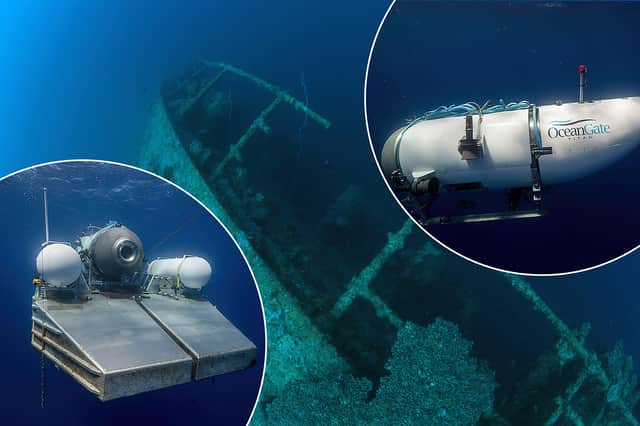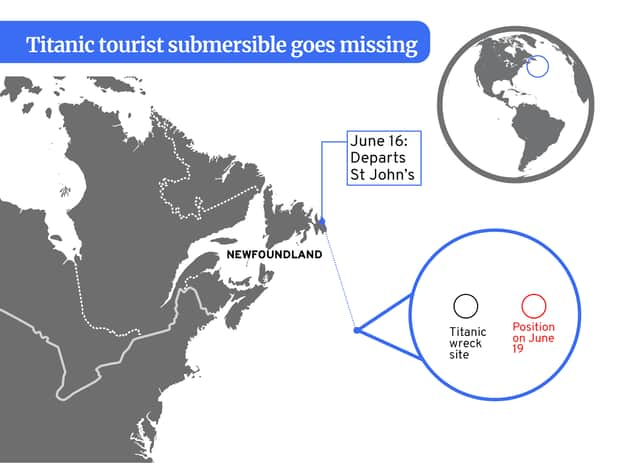Missing Titanic submarine: searchers 'don't know' cause of banging sounds - as more heard in race against time
and live on Freeview channel 276
There is only around 20 hours of life support left on a submersible that disappeared with five onboard near the Titanic wreck site, but rescuers say they remain "optimistic" - with more equipment on the way.
The submersible, named Titan, lost communication with tour operators on Sunday (18 June) while about 435 miles south of St John’s, Newfoundland, during a voyage to the shipwreck off the coast of Canada.
Advertisement
Hide AdAdvertisement
Hide AdFive people are onboard the vessel, including British billionaire Hamish Harding, chairman of private plane firm Action Aviation. The others on board are Shahzada Dawood, his son Suleman and OceanGate’s chief executive and founder Stockton Rush, reportedly together with French submersible pilot Paul-Henry Nargeolet.
In an update on Wednesday evening UK-time, Captain Jamie Frederick of the US Coast Guard said searchers “don’t know” what caused the mystery noises heard in the search area earlier in the day, but believes they are looking in the right area.
Searches of the areas where the underwater sounds were detected had so far "yielded negative results", he said, but were continuing. The data would be shared with military experts, to be analysed further, but so far their experts remained unsure what might have caused the sounds - although more noises had since been picked up by their equipment.
Captain Frederick said he hoped more remote-operated underwater vehicles would arrive in the morning, as they continue to search the area around the sounds, the BBC reports. Some would have extra depth capability, he added.


Advertisement
Hide AdAdvertisement
Hide AdHe also said a rectangular object spotted by an aircraft on Tuesday was determined not to be part of the missing sub. The search are has been expanded, and is now "two times the size of Connecticut", CNN reports.
"We have to remain optimistic and hopeful when we are in a search and rescue case," Captain Frederick told reporters. "There are a lot of factors you have to consider. After considering all those factors, sometimes you're in a position where you have to make a tough decision. We're not there yet."
US Coast Guard Rear Admiral John Mauger told the BBC earlier on Wednesday they estimated there were around 20 hours of oxygen left, but it was a difficult calculation "because it depends on the number of occupants and their consumption".
The guard said the vessel's 96-hour emergency life support supply would likely run out on Thursday morning - provided those on board had survived this long at all. “That said, we are continuing to put all available resources into the search right now and will continue to prioritise the search as we go forward.”
Advertisement
Hide AdAdvertisement
Hide AdWhen asked about different scenarios should they find Titan, Mauger said they have a number of plans in place for different circumstances.
He told BBC: “While our unified command is fully focused on the search we have experts that are working those different scenarios and we have mobilised gear on site, we have lift capabilities on the vessels that are on site now we have additional lift capability coming in."
The Coast Guard spoke to families on Tuesday night, he said. “We understand from the emergency life-support system that there is a possibility and so we are prosecuting this to the fullest of our ability."
On Wednesday morning, and aircraft detected "underwater noises" in the search area, the Coast Guard said. "As a result, ROV (remote operating vehicles) operations were relocated in an attempt to explore the origin of the noises.
Advertisement
Hide AdAdvertisement
Hide Ad“Those ROV searches have yielded negative results but continue. Additionally, the data from the P-3 aircraft has been shared with our U.S. Navy experts for further analysis which will be considered in future search plans.”
The Explorers’ Club, of which Mr Harding is a founding member, shared an upbeat message after the noises were detected, saying it likely indicates signs of life. President Richard Garriot de Cayeux said in a statement: “There is cause for hope, that based on data from the field, we understand that likely signs of life have been detected at the site.
“They precisely understand the experienced personnel and tech we can help deploy… We believe they are doing everything possible with all the resources they have.”
Chris Brown, a fellow explorer and friend of British billionaire Hamish Harding, said making “banging sounds” is the kind of thing his missing friend would do. Speaking to BBC Breakfast, he said: “That is just the sort of thing I would have expected Hamish to come up with”, adding: “There’s always hope. As an explorer, you never give up anyway.”


Advertisement
Hide AdAdvertisement
Hide AdThe missing vessel takes passengers down thousands of metres under the Atlantic to dive through the ruins of the famous ship - which hit an iceberg on its maiden voyage to New York in 1912, with more than half of the 2,200 people on board perishing in the disaster.
The BBC first reported on Monday (19 June) that the US Coastguard had launched an operation to find the missing submersible, which carries experts and tourists who pay out tens of thousands of dollars on an eight-hour voyage to view the ruins.
The US Coast Guard said military aircraft were involved in the search, and on Tuesday a Canadian aircraft has joined the operation, which can conduct sonar searches. As of Tuesday morning, 10,000 square miles of sea surface had been searched.
At a press conference on Tuesday afternoon, Coast Guard Captain Jamie Frederick said they had been working "around the clock" to find the sub, but it has been a "complex search" needing specialised equipment, CNN reports.
Advertisement
Hide AdAdvertisement
Hide AdThe submersible lost contact 1 hour and 45 minutes into its dive on Sunday, and Captain Frederick said at the time, officials estimated it had 96 hours of life support. "We know there's about 40 hours of breathable air left based on that initial report.
Search efforts had not yielded any results yet, he said, but the US Coast Guard was working with both the Canadian Coast Guard and the US Navy, and a number of privately-owned vessels were also en route to join the search operation. CNN also reported an undersea pipe-laying vessel called Deep Energy had started a dive at the sub's last known position, to see what it could find.
BBC reports this vessel is remotely operated, but had a camera onboard. Captain Frederick said if it finds something, experts will figure out the "best course of action" from there.
On social media this weekend, Mr Harding said he was “proud to finally announce” that he would be aboard the mission to the wreck of the Titanic. The Explorers’ Club, of which Mr Harding is a founding member, shared the news of his disappearance on Instagram with club president Richard Garriot saying: “When I saw Hamish last week… his excitement about this expedition was palpable.
Advertisement
Hide AdAdvertisement
Hide Ad“I know he was looking forward to conducting research at the site. We all join in the fervent hope that the submersible is located as quickly as possible and the crew is safe.”
On Tuesday Action Aviation released a statement, which said: “Both the Harding family and the team at Action Aviation are very grateful for all the kind messages of concern and support from our friends and colleagues.
“We are thankful for the continued efforts of the authorities and companies that have stepped in to aid in the rescue efforts. We put great faith and trust in their expertise," it continued.


Captain Hamish Harding, "a living legend of aviation" who holds three Guinness World Records, was no newcomer to submersibles, the company said, having previously travelled on a submersible to the Challenger Deep in the Mariana Trench. “The team at Action Aviation are extremely proud of Hamish and we look forward to welcoming him home."
Advertisement
Hide AdAdvertisement
Hide AdDowning Street said the government was ready to provide support and assistance if needed, but was not aware of a request from the family of Hamish Harding for help.
“We are ready to provide assistance. At this stage I’m not aware they’ve specifically requested assistance from our capacity, which is based in Clyde in the the naval base there," the Prime Minister’s official spokesman said.
"Clearly it is a complex rescue mission at significant depth... We are in contact with the relevant authorities and are ready to provide assistance, but clearly it is an unusual rescue operation given the depths involved.”
Shahzada Dawood and his son Sulaiman Dawood have been named as two of the other people on the submersible in a family statement. A statement from the Dawood Family, obtained by CNN said: “As of now, contact has been lost with their submersible craft and there is limited information available.”
Advertisement
Hide AdAdvertisement
Hide Ad“We are very grateful for the concern being shown by our colleagues and friends and would like to request everyone to pray for their safety while granting the family privacy at this time. The family is well looked after and are praying to Allah for the safe return of their family members.”
A major search and rescue operation, led by the US Coast Guard and involving military aircraft 900 miles east of Cape Cod, was continuing on Tuesday (20 June). The US Coast Guard said the Canadian research vessel Polar Prince and 106 Rescue wing will continue to conduct surface searches while the US Coast Guard sent two C-130 flights to search for the missing submersible.


Rear Admiral John W Mauger of the US Coast Guard said the team are doing “everything” they can to find the submersible, saying it has one pilot and four mission specialists aboard with between 70 and 96 hours of emergency oxygen on board.
On Monday, he said: “We anticipate that there’s somewhere between 70 to the full 96 hours at this point. It is a remote area and a challenge, but we are deploying all available assets.” He added that additional resources would arrive in the coming days.
Advertisement
Hide AdAdvertisement
Hide AdMark Butler, managing director of Action Aviation, said: “There is still plenty of time to facilitate a rescue mission, there is equipment on board for survival in this event. We’re all hoping and praying he comes back safe and sound.”
OceanGate Expeditions confirmed it owned the missing vessel and said its focus was on those aboard the vessel and their families. It said in a statement: “We are deeply thankful for the extensive assistance we have received from several government agencies and deep sea companies in our efforts to re-establish contact with the submersible. We are working toward the safe return of the crew members.”
In 2021, OceanGate Expeditions began what it said would become an annual voyage to chronicle the deterioration of the supersized passenger liner. The company said at the time that in addition to archaeologists and marine biologists, the expeditions also would include roughly 40 paying tourists who would take turns operating sonar equipment and performing other tasks in the five-person submersible.
The initial group of tourists was funding the expedition by spending anywhere from $100,000 to 150,000 US dollars (£78,000 to £117,000) each.
Comment Guidelines
National World encourages reader discussion on our stories. User feedback, insights and back-and-forth exchanges add a rich layer of context to reporting. Please review our Community Guidelines before commenting.